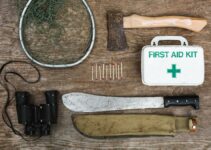Basic Survival Items for Shelter
Surviving a disaster or emergency situation can be challenging, especially if you do not have the necessary supplies. That is why it is crucial to have a survival kit that contains essential items. In this article, we will explore the top survival items you need for your shelter.
1. Water
Water is essential for survival, and you should have enough for at least three days. The CDC recommends having at least one gallon of water per person per day. You should also have extra water for cooking, cleaning, and pets. It is also a good idea to have a water filtration system or water purification tablets in case you run out of clean water.
2. Food
Non-perishable food is another vital item for your shelter. You should have enough food to last for at least three days. Canned foods, dried fruits, and energy bars are excellent choices because they have a long shelf life. Don't forget to include a manual can opener in your kit.
3. First Aid Kit
Injuries can happen during a disaster or emergency situation, so having a first aid kit is crucial. Your kit should include bandages, gauze pads, antiseptic wipes, and pain relievers. You should also include any prescription medications you or your family members need.
4. Flashlight with Extra Batteries
Power outages are common during disasters, so having a flashlight with extra batteries is essential. You can also use a hand-cranked flashlight that does not require batteries.
5. Radio
A battery-powered or hand-cranked radio is another essential item for your shelter. You can use it to stay informed about the situation and receive emergency alerts.
Additional Items for Shelter
Aside from the basic items, there are several other items you should consider adding to your survival kit to ensure your safety and comfort during a disaster or emergency situation.
1. COVID-19 Prevention Items
The COVID-19 pandemic has highlighted the need for additional items in your survival kit. The Centers for Disease Control and Prevention (CDC recommends having masks, hand sanitizer, and disinfecting wipes in your kit to prevent the spread of the virus. These items can also be used to prevent the spread of other illnesses.
2. Shelter-in-Place Kit
The CDC advises having a shelter-in-place kit with essential items for 3-5 days in case of a disaster. In addition to the basic items listed above, your kit should include the following:
- Clothing and Bedding: Warm clothing and blankets are essential if you lose power or heat during a disaster (The Ready Store.
- Hygiene Kit: Toothbrush, toothpaste, soap, and other personal hygiene items (The Ready Store.
- Can Opener: A manual can opener is essential if you have canned food in your kit (The Ready Store.
- Radio: A battery-powered or hand-cranked radio is necessary to stay informed about the situation and receive emergency alerts (Ready.gov.
3. Choosing Quality and Reliable Items
When preparing your survival kit, it is essential to choose quality and reliable items. You do not want to have items that will fail when you need them the most. Look for items with good reviews and a long shelf life (More Prepared.
4. Maintaining Your Kit
Once you have assembled your survival kit, it is essential to maintain it. Check your kit regularly to ensure that all items are up-to-date and in good condition. Replace any expired items and update your kit as necessary (Red Cross.
Tips for Preparing Your Shelter Kit
Preparing a survival kit can be overwhelming, especially if you are not sure where to start. Here are some tips to help you prepare your kit:
1. Prepare Supplies for Home, Work, and Cars
Disasters can happen anywhere, so it is important to have supplies in multiple locations. Prepare a kit for your home, your workplace, and your car. Make sure your family members and coworkers know where the kits are located.
2. Choosing Quality and Reliable Items
When preparing your survival kit, it is essential to choose quality and reliable items. You do not want to have items that will fail when you need them the most. Look for items with good reviews and a long shelf life (More Prepared.
3. Maintaining Your Kit
Once you have assembled your survival kit, it is essential to maintain it. Check your kit regularly to ensure that all items are up-to-date and in good condition. Replace any expired items and update your kit as necessary (Red Cross.
By following these tips, you can ensure that your survival kit is up-to-date and ready for any emergency situation.
Additional Tips for Sheltering in Place
Sheltering in place can be a challenging experience, especially if you are not prepared. Here are some additional tips to help you stay safe and comfortable during a disaster:
1. Stay Informed
Stay informed about the situation by listening to the radio or checking social media for updates. Follow the instructions of local authorities and emergency services.
2. Make a Plan
Create a plan for what you will do in case of a disaster. This plan should include where you will go, what supplies you will need, and who you will contact. Practice your plan regularly with your family members or roommates.
3. Stay Connected
Stay connected with your loved ones and community during a disaster. Use social media or messaging apps to check in with friends and family. Join community groups or online forums to stay informed and connect with others.
4. Take Care of Your Mental Health
Sheltering in place can be a stressful experience. Make sure to take care of your mental health by practicing self-care, staying connected with others, and seeking professional help if necessary.
By following these additional tips, you can stay safe and comfortable during a disaster while sheltering in place.
Conclusion
Having a survival kit with the essential items for sheltering is crucial in times of crisis. It is important to prepare a kit that includes basic items such as water, food, a radio, flashlight, and first aid kit, as well as additional items recommended by the CDC to prevent the spread of COVID-19, such as masks, hand sanitizer, and disinfecting wipes.
In addition to the basic items, you should also consider adding other items to your kit to ensure your safety and comfort during a disaster. When preparing your kit, choose quality and reliable items, and maintain your kit regularly by checking for expired items and updating it as necessary.
Finally, make sure to stay informed, make a plan, stay connected, and take care of your mental health during a disaster while sheltering in place. By following these tips and preparing ahead of time, you can ensure that you and your loved ones are ready for any emergency situation.
Stay Prepared with The Prepper.Live
At The Prepper.Live, we strive to help people prepare for any emergency situation. We offer a wide range of articles, guides, and resources to help you stay prepared and informed. Here are some of our popular articles related to emergency preparedness:
1. Emergency Food Storage: How to Build Your Stockpile
Learn how to build your food stockpile for emergencies with our comprehensive guide. We cover everything from choosing the right storage containers to selecting the right foods.
2. The Ultimate Bug Out Bag Checklist: What to Pack for Emergencies
A bug out bag is a crucial item for emergency situations. In this article, we provide a comprehensive checklist of items to include in your bug out bag.
3. Emergency Water Storage: How to Store Water for Long-Term Emergencies
Water is essential for survival, especially during emergencies. In this article, we provide tips on how to store water for long-term emergencies.
4. Survival Gardening: How to Grow Your Own Food in a Crisis
Having a survival garden is an excellent way to ensure a steady supply of fresh food during emergencies. In this article, we provide tips on how to start your own survival garden.
Check out these articles and more on The Prepper.Live to stay prepared for any emergency situation.
Questions
Who needs survival items for shelter?
Everyone should have a survival kit with essential items for sheltering in place during a disaster.
What items should be included in a survival kit for sheltering in place?
A survival kit should include water, food, a radio, flashlight, first aid kit, masks, hand sanitizer, and disinfecting wipes.
How often should I update my survival kit?
You should update your survival kit every six months and check for expired items to ensure that it is always up-to-date.
What if I can't afford to purchase a pre-made survival kit?
You can create a survival kit with items you already have at home, such as water bottles, canned food, and first aid supplies.
How can I stay informed during a disaster while sheltering in place?
Listen to the radio or check social media for updates and follow the instructions of local authorities and emergency services.
What if I don't have a shelter to go to during a disaster?
You can create a shelter in place by finding a safe and secure location in your home and preparing it with essential items.


